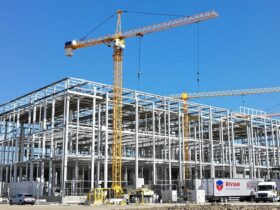Ford Motor Company CEO Jim Farley announced the extension of the automaker’s employee pricing program through July 4, 2025, in response to rising consumer concerns over potential price increases due to new tariffs on imported vehicles and auto parts. This move aims to stimulate sales as the automotive industry braces for economic shifts.
Key Takeaways
- Employee pricing extended until July 4, 2025.
- Rising tariffs on imported vehicles and parts may lead to increased car prices.
- Ford’s pricing strategy will depend on competitors’ actions.
- CEO emphasizes the importance of affordable parts for maintaining vehicle prices.
Background on Tariffs and Pricing Strategy
The automotive industry is currently facing significant challenges due to tariffs imposed by the U.S. government. A 25% tariff on imported vehicles and parts is set to take effect, which could substantially increase production costs for automakers. Farley highlighted that while the employee pricing initiative is designed to keep prices competitive, the future pricing landscape remains uncertain.
Farley stated, “We want to keep our prices competitive and low. We think this is an opportunity for Ford. We have a different footprint, a different exposure for tariffs.” This indicates that Ford’s manufacturing strategy, which relies heavily on U.S. production, may provide some buffer against the impacts of these tariffs.
The Impact of Tariffs on Production Costs
The new tariffs are expected to raise production costs significantly. Analysts estimate that the tariffs could add between $3,000 to $12,000 to the cost of producing vehicles at American plants. Although the recent changes to tariff policies may reduce some of these costs, the overall impact on consumer prices is still anticipated to be substantial.
- Estimated Cost Increases Due to Tariffs:
- Production Cost Increase: $3,000 to $12,000 per vehicle
- Potential Reduction from New Policies: $900 to $2,500
Ford’s Commitment to American Manufacturing
Farley emphasized Ford’s commitment to American manufacturing, stating that the company is a net exporter of vehicles and parts. However, he also acknowledged the reality of relying on imported parts for certain components, which complicates the pricing strategy. He noted, “We have to import certain parts. A lot of parts, like fasteners, washers, carpet, are just not available. We can’t even buy those parts here.”
This dependency on global supply chains highlights the challenges faced by automakers in balancing domestic production with the need for affordable components. Farley reiterated the importance of maintaining affordability in vehicle pricing, stating, “The affordability of parts is a really important thing for America because we’ve got to keep the vehicles affordable.”
Looking Ahead
As the automotive industry navigates these turbulent waters, Ford’s extension of employee pricing is a strategic move to maintain consumer interest amid rising costs. However, the future remains uncertain as the company monitors competitor pricing strategies and the ongoing impact of tariffs.
In conclusion, while Ford aims to provide value to its customers through initiatives like employee pricing, the looming threat of increased production costs due to tariffs poses a significant challenge. The company will need to adapt its strategies to ensure it remains competitive in a rapidly changing market.
FAQ: Ford Extends Employee Pricing Amid Rising Tariffs
1. Why has Ford extended its employee pricing program?
Ford extended its employee pricing program through July 4, 2025, in response to rising consumer concerns over potential vehicle price increases caused by new tariffs on imported vehicles and auto parts.
2. How long is the employee pricing program extended?
The employee pricing program has been extended until July 4, 2025.
3. What tariffs are affecting the automotive industry?
The automotive industry faces a 25% tariff on imported vehicles and auto parts, significantly raising production costs and potentially leading to increased consumer prices.
4. How much are production costs expected to increase due to tariffs?
Analysts estimate that tariffs could increase production costs by $3,000 to $12,000 per vehicle. Recent tariff policy adjustments might reduce these costs by approximately $900 to $2,500 per vehicle, but substantial impacts remain likely.
5. What did Ford CEO Jim Farley say about Ford’s pricing strategy?
CEO Jim Farley emphasized Ford’s goal to keep prices competitive and low, viewing the current tariff situation as an opportunity due to Ford’s distinctive manufacturing footprint and lesser exposure compared to competitors.
6. How does Ford’s U.S.-based manufacturing help mitigate the impact of tariffs?
Ford’s heavy reliance on U.S. manufacturing reduces its exposure to tariffs compared to automakers who import more vehicles. However, Ford still imports essential components, complicating its overall pricing strategy.
7. Why can’t Ford source all vehicle parts domestically?
Ford faces challenges sourcing certain parts domestically, including essential components like fasteners, washers, and carpets, due to limited availability in the U.S. market.
8. How important is affordability in Ford’s strategy?
Affordability is crucial for Ford. Farley emphasized that maintaining affordable prices for parts and vehicles is essential to ensuring vehicles remain accessible to consumers amid increasing production costs.
9. How will Ford respond to competitors’ pricing strategies?
Ford’s future pricing decisions will depend significantly on how competitors react to tariff-induced cost increases, highlighting the importance of adaptability in the evolving automotive market.













Leave a Reply